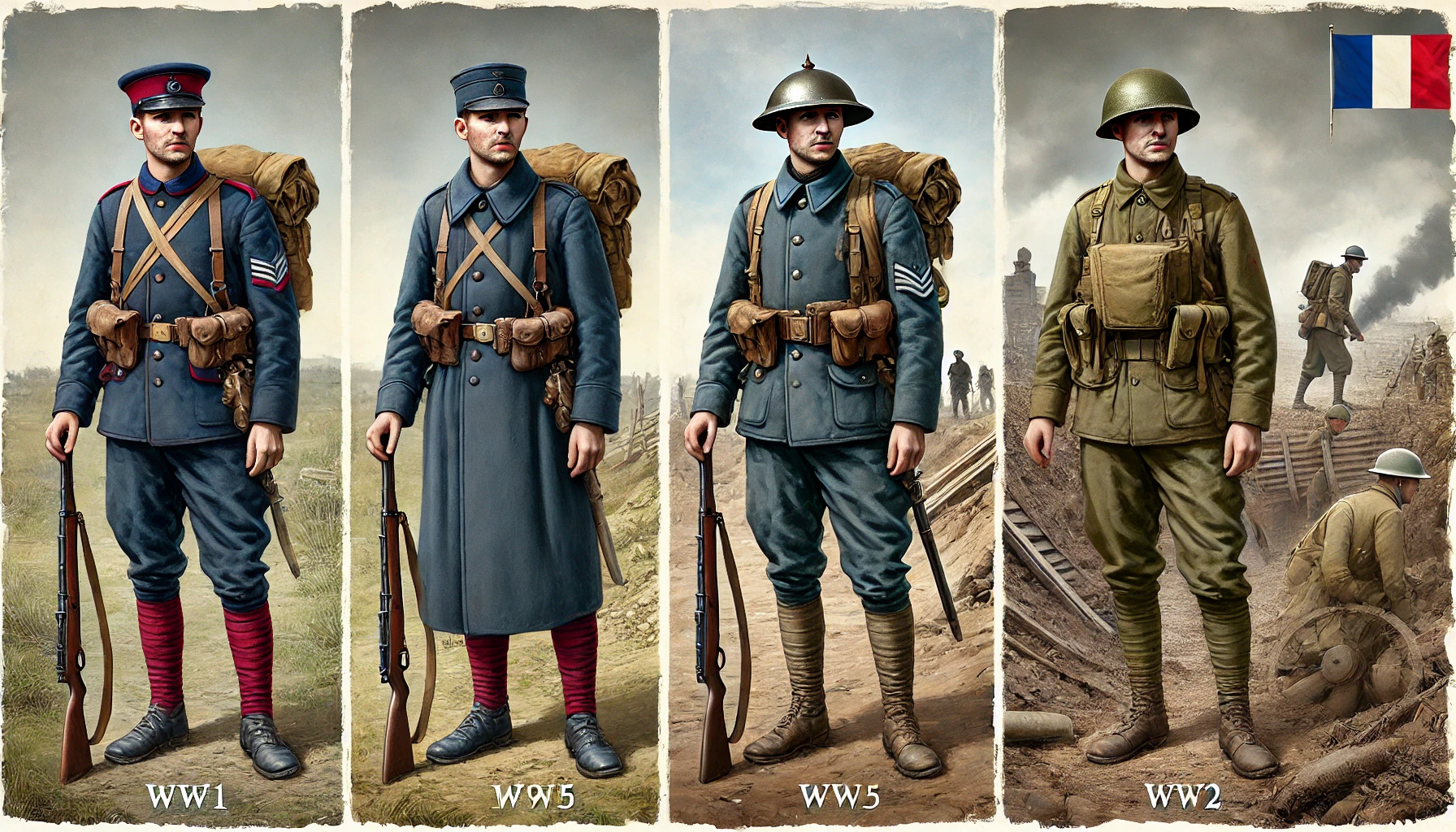
The Evolution of WW1 French Uniforms: History, Design & Legacy
Published on Mar 11, 2025
WW1 French Uniform History: Evolution, Design & Influence
Introduction
During World War 1, the French military uniform underwent significant changes, adapting to the demands of modern warfare. Initially influenced by traditional 19th-century designs, these uniforms became more practical and protective. This article explores the history, design, and impact of WW1 French uniforms, tracing their transformation and how they influenced later French military attire, including WW2 French uniforms and even French Revolution-era styles.
Pre-WW1 French Military Attire
Before World War 1, French soldiers wore uniforms influenced by 19th-century warfare. The “madder red” trousers and dark blue tunics were iconic but impractical for the new battlefield conditions. These bright colors made soldiers highly visible, an issue that quickly became apparent as trench warfare and modern weaponry took hold.
Key Features of Pre-WW1 French Uniforms:
- Dark Blue Tunics & Red Pants: Inspired by Napoleonic-era designs
- Képi Caps: A soft cap worn by infantry and officers
- Leather Gaiters & Heavy Boots: Designed for marching but offered little protection
By 1914, the need for camouflage and durability led to a shift in uniform design.
WW1 French Uniform Evolution: The Transition to Horizon Blue
Why the Change?
At the outbreak of WW1, the bright-colored uniforms quickly became a disadvantage. French soldiers were easy targets on the battlefield, leading to high casualties. By late 1914, the French Army introduced a new horizon blue uniform to blend better with the surroundings.
Features of WW1 French Uniforms:
- Horizon Blue Wool Fabric: A grayish-blue color that offers better camouflage in battlefield conditions.
- Adrian Helmet (1915): A significant upgrade from the traditional képi cap, providing much-needed head protection.
- Long Greatcoat (Capote): A heavy wool coat that provided warmth and durability in trenches.
- Puttees or Gaiters: Wrapped fabric around the lower legs to prevent mud and debris from entering boots.
The M1915 Adrian Helmet was a major improvement in soldier safety. Made of metal, it significantly reduced head injuries compared to earlier soft caps.
Comparison: WW1 vs. WW2 French Uniforms
WW1 uniforms influenced later designs, especially in World War 2. The French Army retained the horizon blue uniform until the late 1920s. Still, by WW2, it transitioned to olive-green and khaki tones for better camouflage.
FeatureWW1 French UniformWW2 French Uniform
Color Horizon Blue Olive Green/Khaki
Headgear Adrian Helmet Adrian Helmet (modified)
Fabric Wool Lighter, breathable fabric
Footwear Heavy leather boots More flexible boots
Greatcoat Long wool capote Shorter, more practical coats
WW2 French uniforms were more modernized and functional, improving mobility and protection than their WW1 predecessors.
Influence of French Revolution Uniforms on WW1 Attire
French military uniforms have a deep historical lineage, tracing back to the French Revolution (1789–1799). The revolution-era uniforms featured bicorne hats, blue coats, and red epaulets, emphasizing national identity. While WWI uniforms differed significantly, some traditional elements, such as structured coats and a distinct color scheme, carried over.
Key Similarities:
- Blue is used as a dominant uniform color.
- The emphasis on military headgear (from bicorne hats to képis and Adrian helmets).
- Rank distinctions through insignias and epaulets.
French Fatigues: Practicality in the Trenches
During WW1, French soldiers often wore fatigues or work uniforms when performing maintenance tasks off-duty. These were more comfortable and practical than formal battlefield attire. Fatigues included:
- Loose-fitting jackets and trousers made of durable fabric.
- Simpler boots and shoes for ease of movement.
- Basic caps or berets instead of helmets.
These fatigues influenced later military designs, emphasizing practicality in modern combat uniforms.
The Legacy of WW1 French Uniforms
WW1 French uniforms set the stage for modern military attire. The lessons learned in uniform design led to the following:
- Improved camouflage techniques in later wars.
- More protective headgear influenced helmets used in WW2 and beyond.
- Enhanced mobility and durability, shaping modern military fatigue wear.
Even today, French military uniforms retain elements of their historical past, blending tradition with contemporary warfare needs.
Conclusion
The evolution of WW1 French uniforms reflects the changing nature of warfare. From bright red trousers to horizon blue coats and, eventually, to the practical designs of WW2, each phase of uniform development showcased a response to battlefield demands. The influence of French Revolution uniforms and French fatigues is still evident in modern military attire.
As we study the past, we gain insights into how military fashion, functionality, and history intertwine, shaping the future of combat apparel.
